Bruno Comby, President of
EFN, builds his ecological dream house* near Paris :
this high-comfort eco-house
requires 20 times less energy and divides by 200 the house's CO2
emissions (compared to a standard European house) !
An exemplary ecological house,
protecting nature, yet providing full modern comfort : highly
efficient ecological heating and air conditioning, constantly renewed
fresh air, regulated hygrometry, the environmentally perfect
dream-house...
* The words "dream house" are shamelessly
taken from the film comedy "Mr
Blandings builds his dream house"
starring Cary Grant and Myrna Loy. The film was a box office hit upon
its release in 1948.
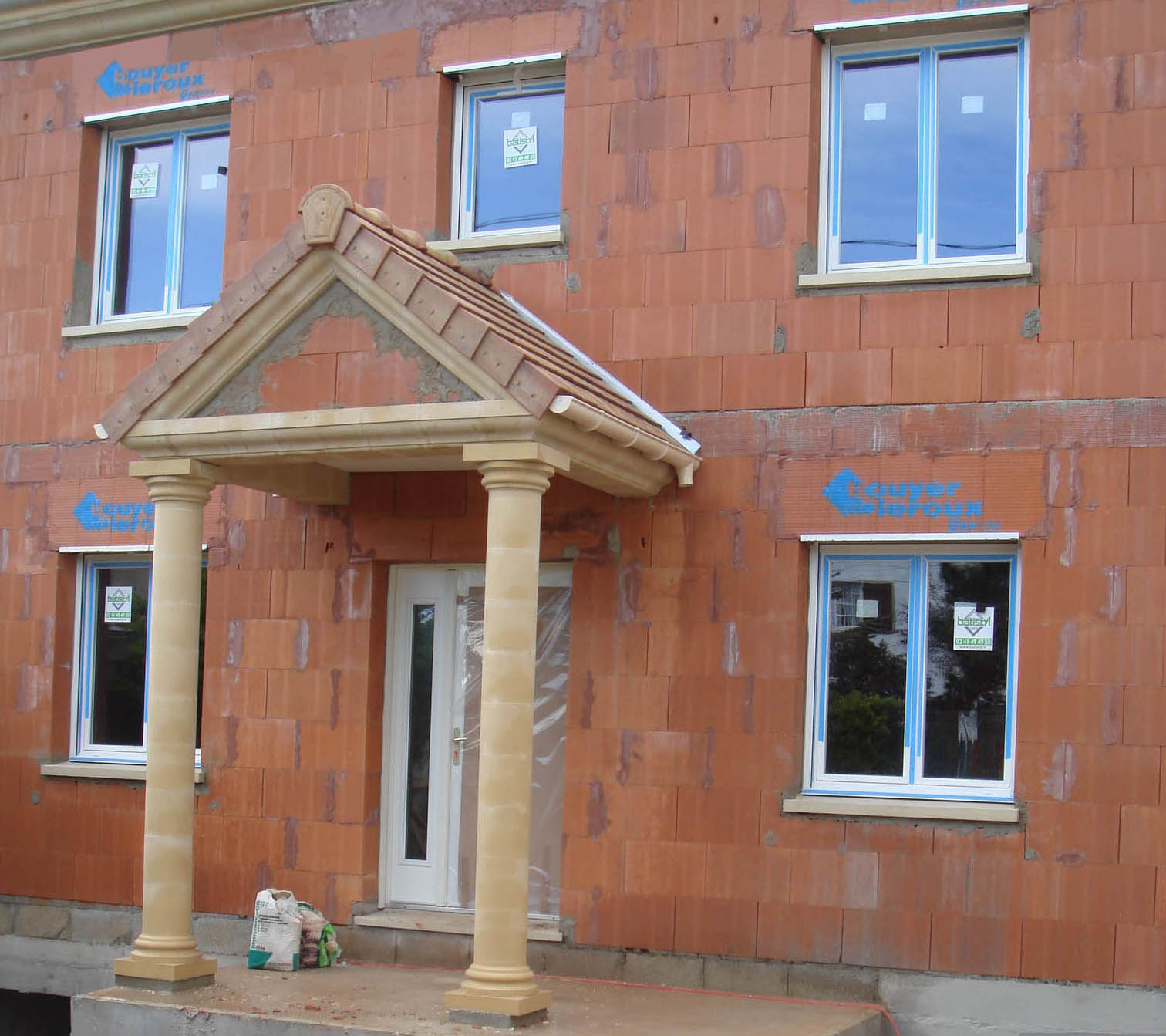
Here is a photo of Bruno's ecological
dream house in construction, in March 2008

Here is a 360° panoramic view of
the ground floor in construction in April 2008
You can see on this panoramic view the
ventilation pipes going upwards to the upper floor, the highly
insulating windows and doors, the highly insulating red bricks (in
addition to rockwool for wall insulation three times more efficient
than usual). By looking closely, you wll also notice the thermal
bridge suppressors (polystyrene blocks at the horizontal junction
between the walls and roofs.
As an environmentalist, Bruno Comby wanted for his family a house
requiring as little energy as possible, yet that can be constructed
for an acceptable price, and that can be duplicated anywhere in the
world.
This house is the result of this dream.
The concept of the house chooses optimal construction methods in
each area and for each equipment for heating, ventilation, air
conditioning, and other equipments. The design of the house was
entirely done, the equipments chosen and their size and efficiency
precisely calculated by Bruno himself in such a way as to reduce the
energy requirement to the maximum possible extent, without
sacrificing modern comfort.
By taking care of the design and also part of the construction
work himself, Bruno maintained the cost of the house quite low,
similar and even lower than that of a standard (unefficient)
house.
The heating and air conditioning of houses and buildings are one
of the main sources of CO2 emissions in the world today. In France,
they represent 93 millions metric tons of CO2 per year, and 42% of
the energy consumption in the country. The primary energy need for
heating the existing homes in France are at an average value of 240
kWh/m2/year in 2007. It is possible, as this dream-house
demonstrates, to build homes that drastically reduce both the energy
requirement and CO2 emissions (up to 200 times less CO2 emitted than
a standard gas-heated home of the same size) simply by constructing
this type of long-lasting efficient homes and buildings that do not
emit (or almost don't emit) any CO2 and even that produce more energy
than they consume (positive energy houses).
The simple techniques that are to be used to reach this goal are
described below. By combining these different, simple and proven
techniques into the same house, as this dream-house shows in Houilles
(a typical suburb of Paris, similar to te surroundings of any large
city in the world), the energy requirement of our homes can be very
much reduced, to almost nothing.
This dream-house can be duplicated and constructed almost anywhere
(there may be just some minor differences to adapt this dream house
to each type of geographical and geological situation and type of
house desired).
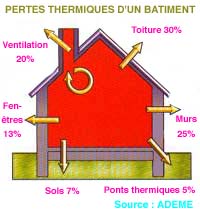
Thermal losses of a typical house (source
ADEME)
Heating, ventilation and air conditioning (HVAC) of houses,
apartments and offices is one of the main sources of CO2 emissiosn in
France as elsewhere. We have the technology at hand to build
dwellings and office buildings which emit almost no CO2. Bruno has
put together a number of these technologies, as we shall show
below.
Here is a partial list of some simple and ecological HVAC building
technologies which he used to build his ecological dream-house at
Houilles near Paris. These reduce the energy consumption by a factor
20 or so, and reduce the CO2 emission by a factor 200, as compared to
gas heating currently being installed in new contruction in
France.
- at the level of planning: minimize the outer surface of the
construction, where heat is exchanged with the surrroundings, by
making the house compact, as near as possible to a cube or sphere
(this house is a cube); and orient it so that the main windows are
toward the south. In winter the sun will contribute to heating the
house and in summer awnings or shutters will keep the sunlight and
direct heat from entering. Plan for thick walls - the thicker the
wall the better it is an insulator, no matter what the material.
- choice of building materials: prefer long lasting insulating
material such as insulating bricks, and cellular concrete like
Siporex (low density concrete) or Insulating bricks that are 5 times
better than classical cinder blocks for the same wall thickness, and
they cost about the same. Insulating bricks moreover have greater
mechanical strength and the mason can build more rapidly with them.
French and European suppliers of insulating bricks include
Wienenberger's Porotherm,
thermopierre (formerly Siporex) sold by
Xella,
monomur
bricks, and Bouyer-Leroux's brique
Thermo BGV . Bruno has chosen to build with Thermo BGV which have
the greatest thermal efficiency (BGV = Briques à Grande
Vitesse "high-speed bricks" because the construction is done in much
less time using these bricks than standard concrete construction).
Click
here to go to the bottom of the page to
see a video and practical instructions for building a wall with these
BGV insulating bricks.
Here are a few snapshots of the ecological
house Bruno is
building:
(photos B.C.)
|
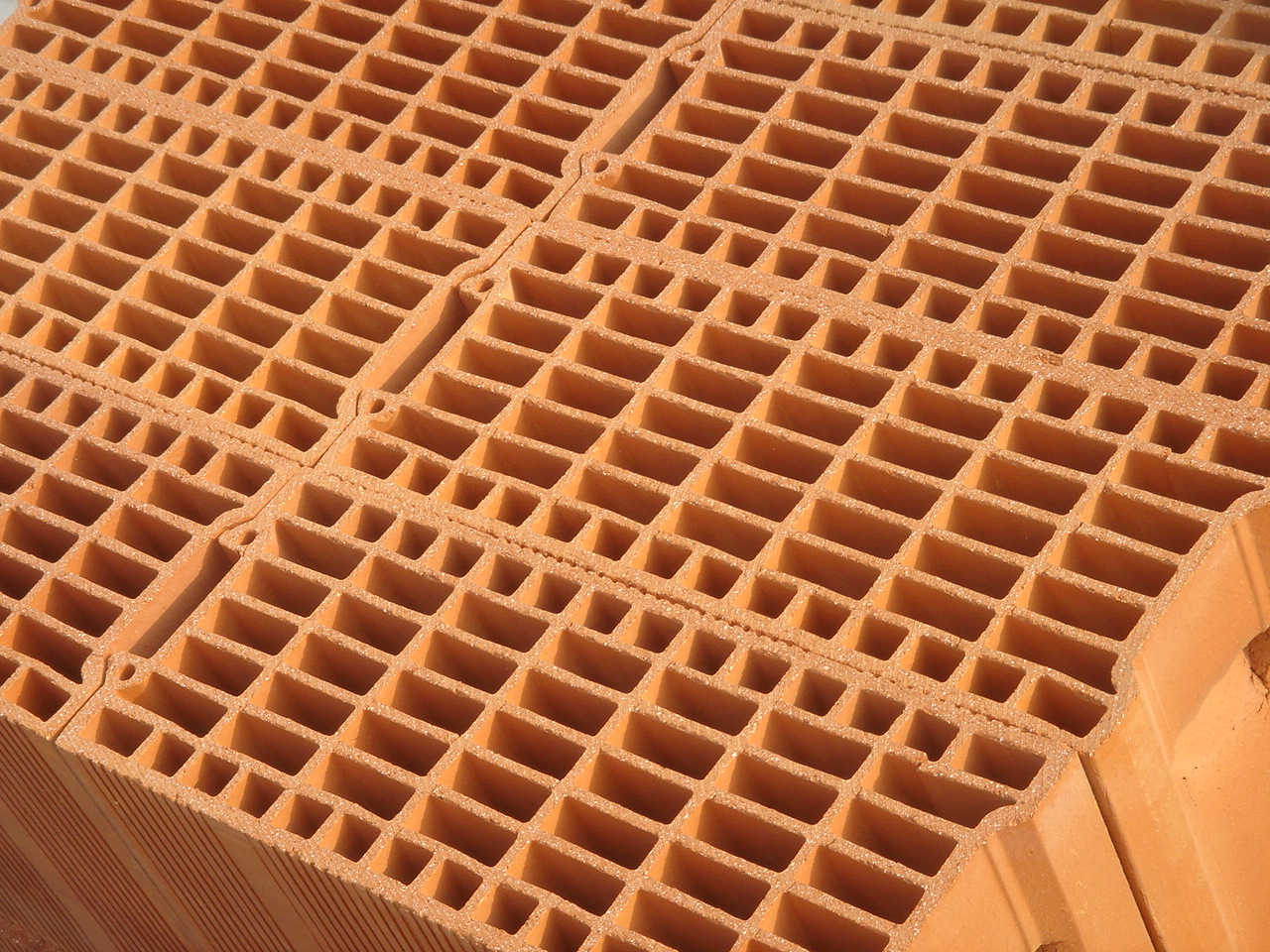
A pallet of insulating bricks has just arrived. They have
a vertical alveolar structure - type BGV - highly insulating
and easy to build with.
|
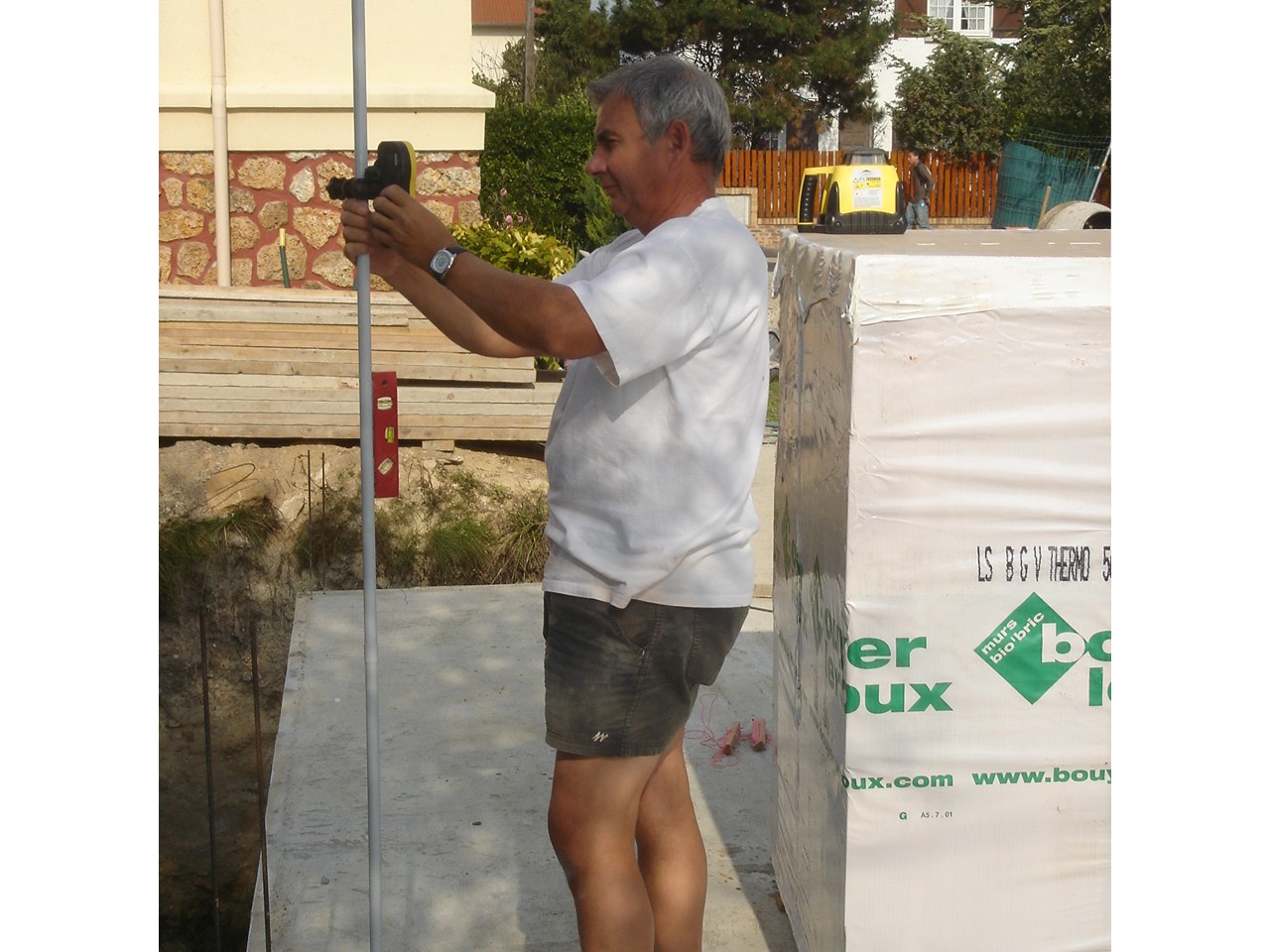
Using a laser to level the first row of bricks accurate
to a millimeter. Since the joints are very thin, the first
layer of bricks must be perfectly level.
|
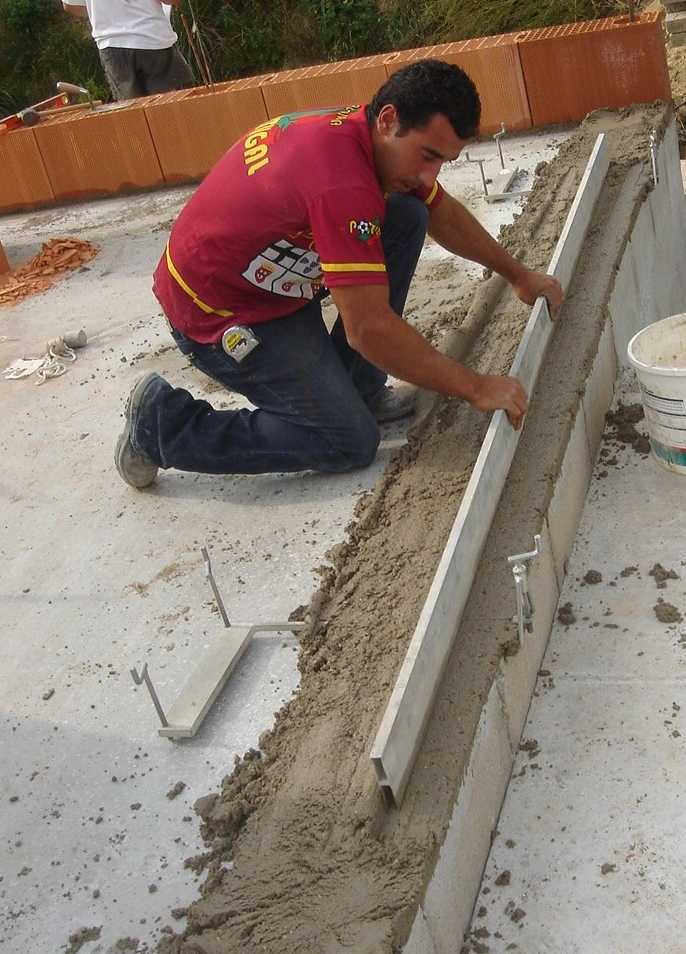
Using a straight-edge to prepare the bed of mortar before
laying the first layer of bricks - it must be perfectly
level and flat.
|
|
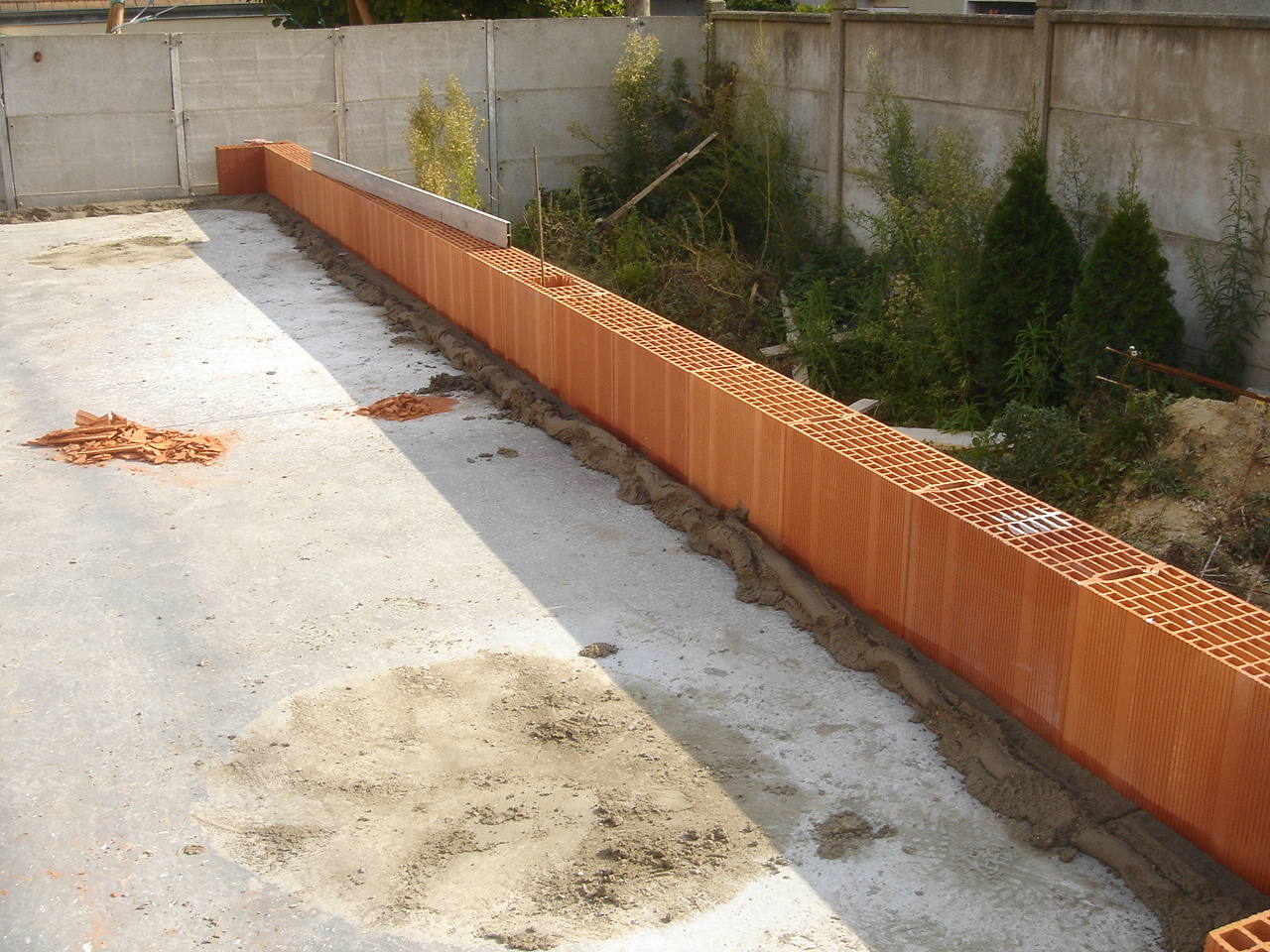
Then the mason can lay the bricks very quickly.
|
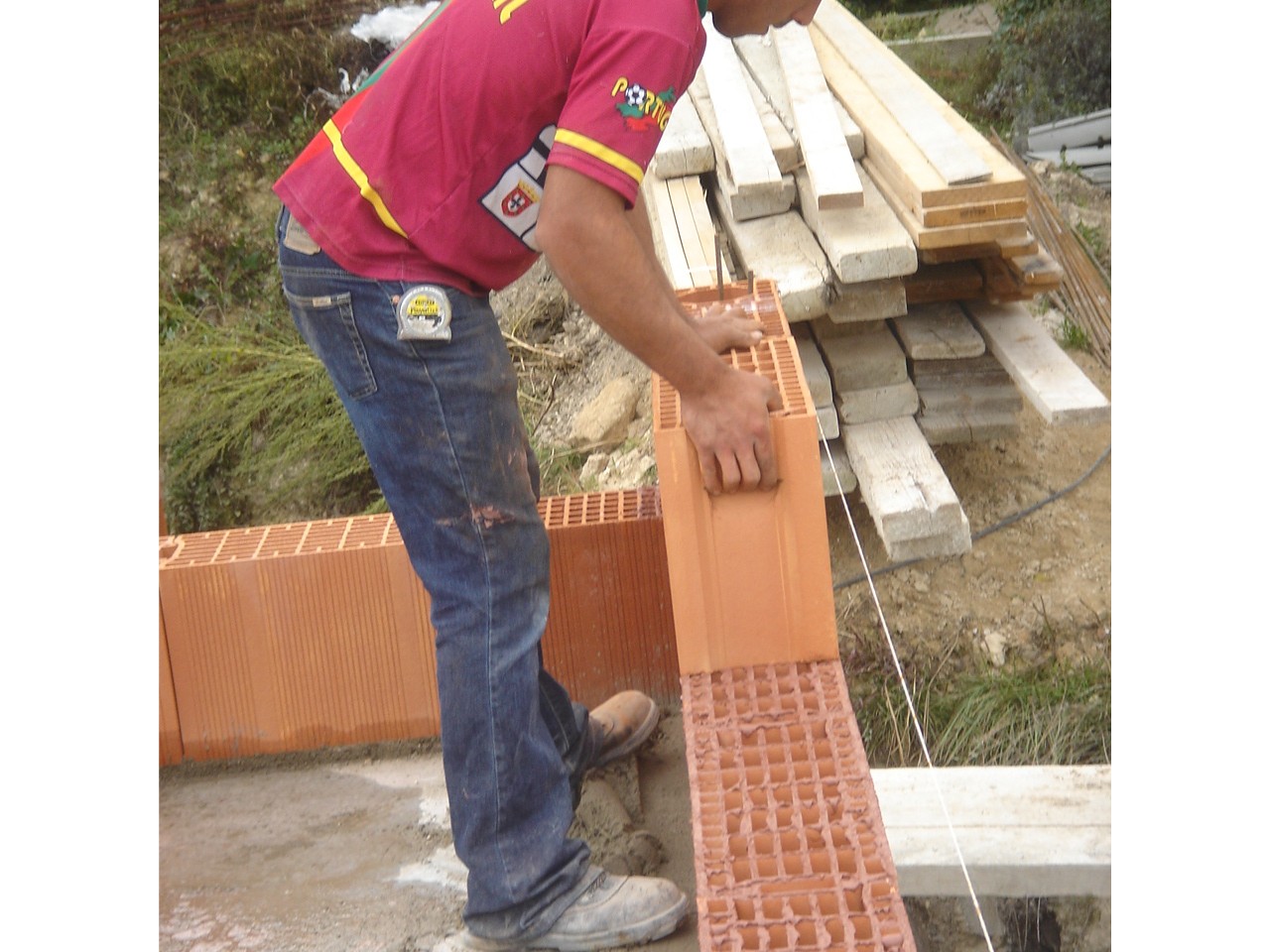
The second layer of bricks.
|
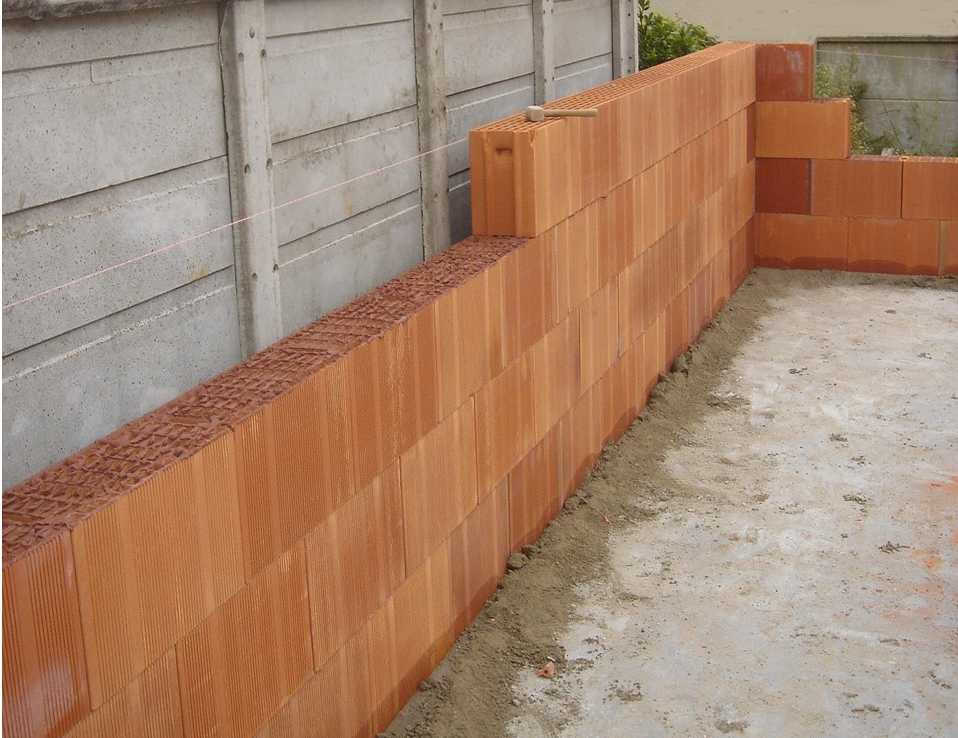
The wall goes up quite fast; it takes little more than a
day to complete each floor.
|
|
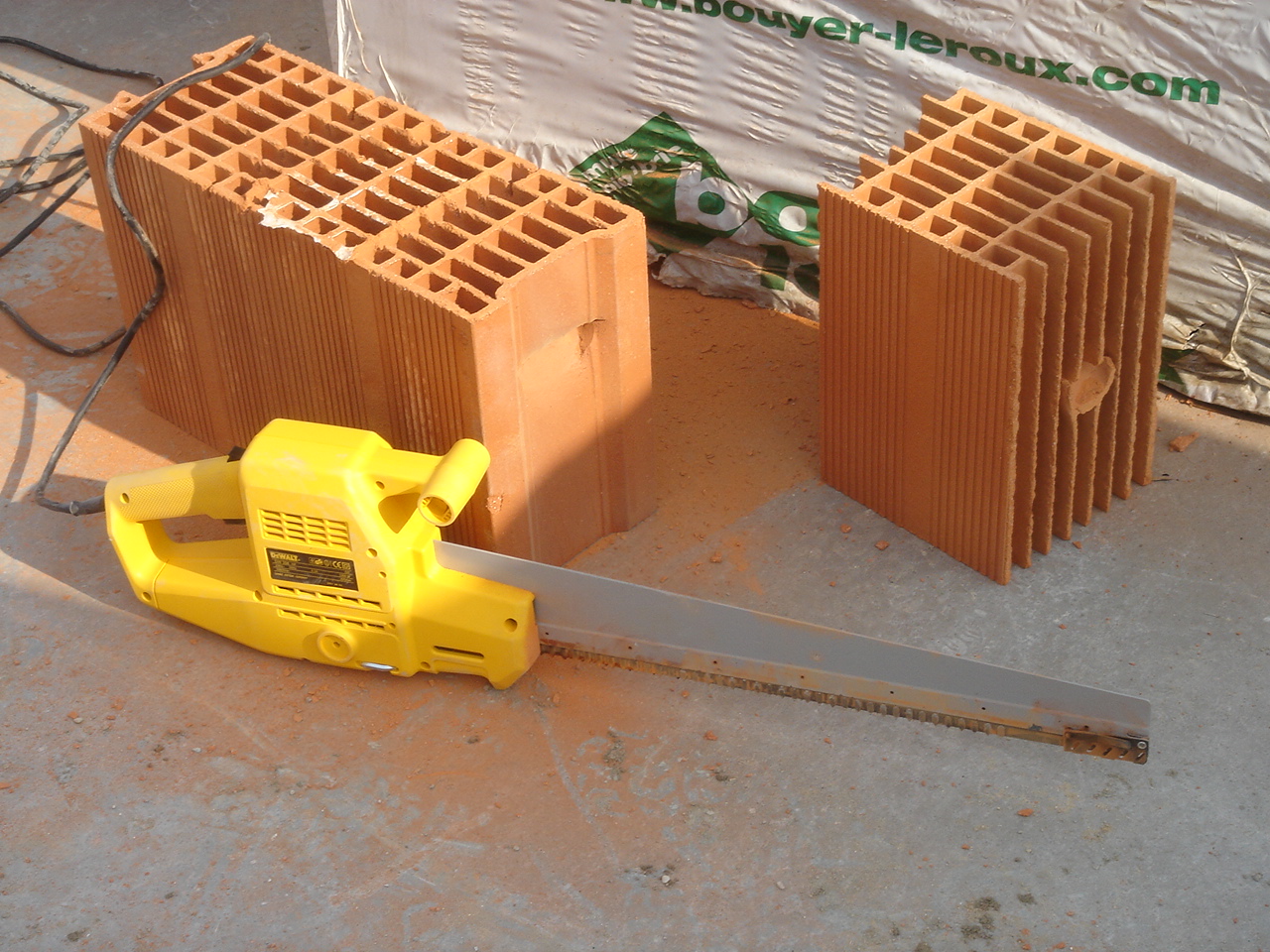
Terra cotta bricks can be cut with an alligator saw.
|

At the level of the intermediate floor slab, the
planelles de rive vertical
bricks on the exterior (in contact with outside
temperatures) are also insulating. This reduces the heat
loss and "thermal bridges" at this level
|

Et voilà le travail !
|
You may click here to see more
of the snapshots taken while we were putting up our ecological
house with THERMO BGV insulating bricks (Briques à Grande
Vitesse - high speed bricks [apologies to SNCF for copying the
TGV, the French high speed Train à Grande Vitesse])
See this video
of putting up a wall of insulating bricks. showing all the clever
tricks of the brick manufacturer, Bouyer-Leroux.
- be sure to make air-tight joints between the masonry walls and
the windows, doors, rolling shutters, and all. If this phase of the
work is properly executed, you will save a lot of energy over the
whole life of the building. Air-tight joints are a simple thing to do
and an important element of a highly efficient home. There is no
point in building a highly efficient home if the joints aren't done
properly (beware of small details).
- break the horizontal thermal bridge where the floors touch the
outside walls. Concrete is an excellect heat conductor; in
traditional construction with concrete floors, each floor is
effectively a radiator of cold, bringing the outside cold into the
warm building through the floors. So are partitions in contact with
the outside walls. To cut this thermal connection one need only lay
down blocks of polystyrene at the outskirt of each floor before
pouring the concrete slab for each floor. The extra cost of
construction is nil or negligible, but the consequent energy savings
are substantial. Unfortunately this is impossible to do in a
renovation. Here are a few snapshots of polystyrene blocks installed
in our ecological house. (Notice the very thin joints between the
bricks to avoid heat heat losses through the joints.)
|
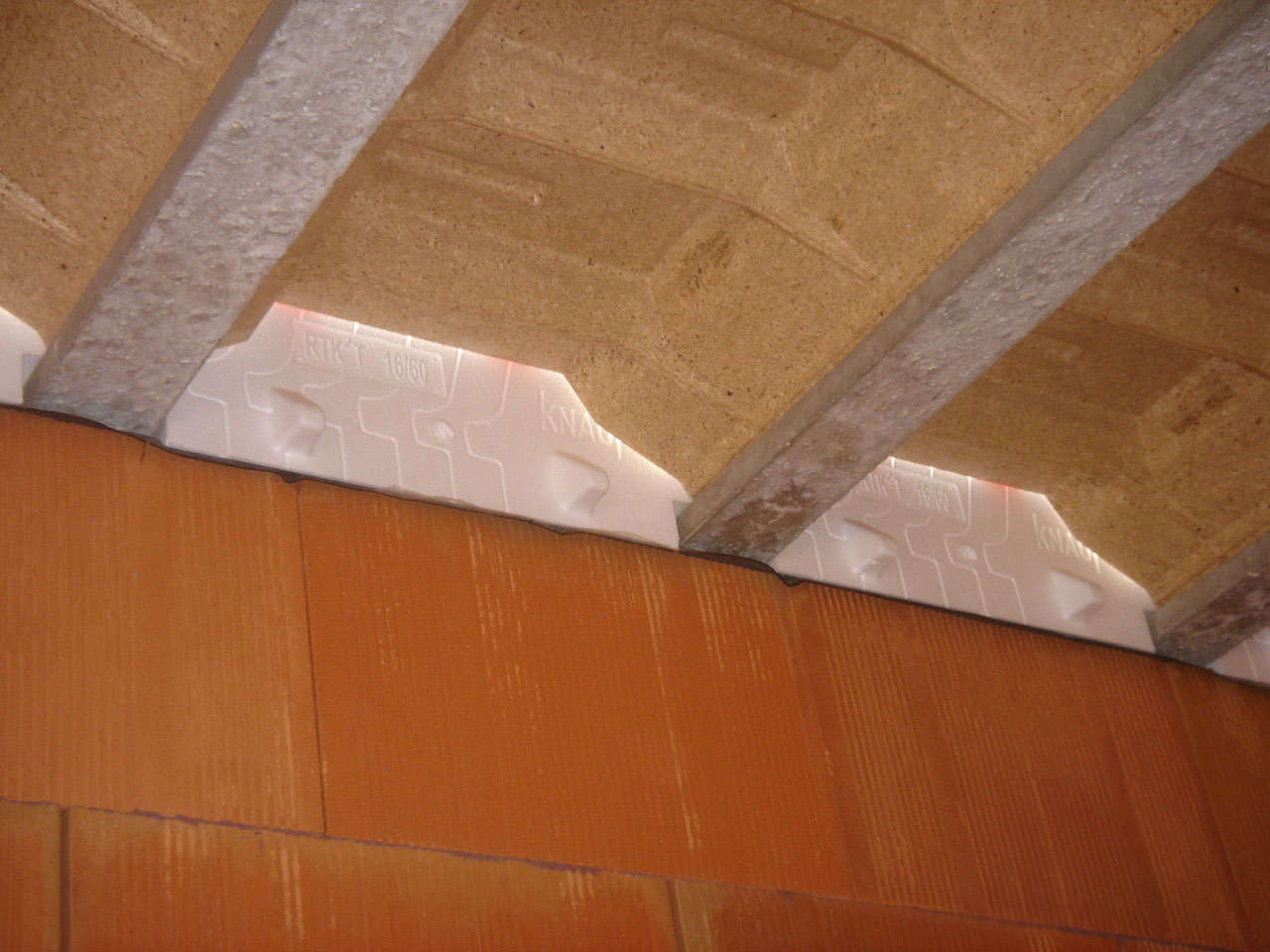
Breaking the thermal connection at the floors. One simply
inserts an insulating block, polystyrene in this case, at
the floor level to prevent the concrete slab from touching
the outside of the building thus preventing cold from
penetratating into the dwelling space.
|
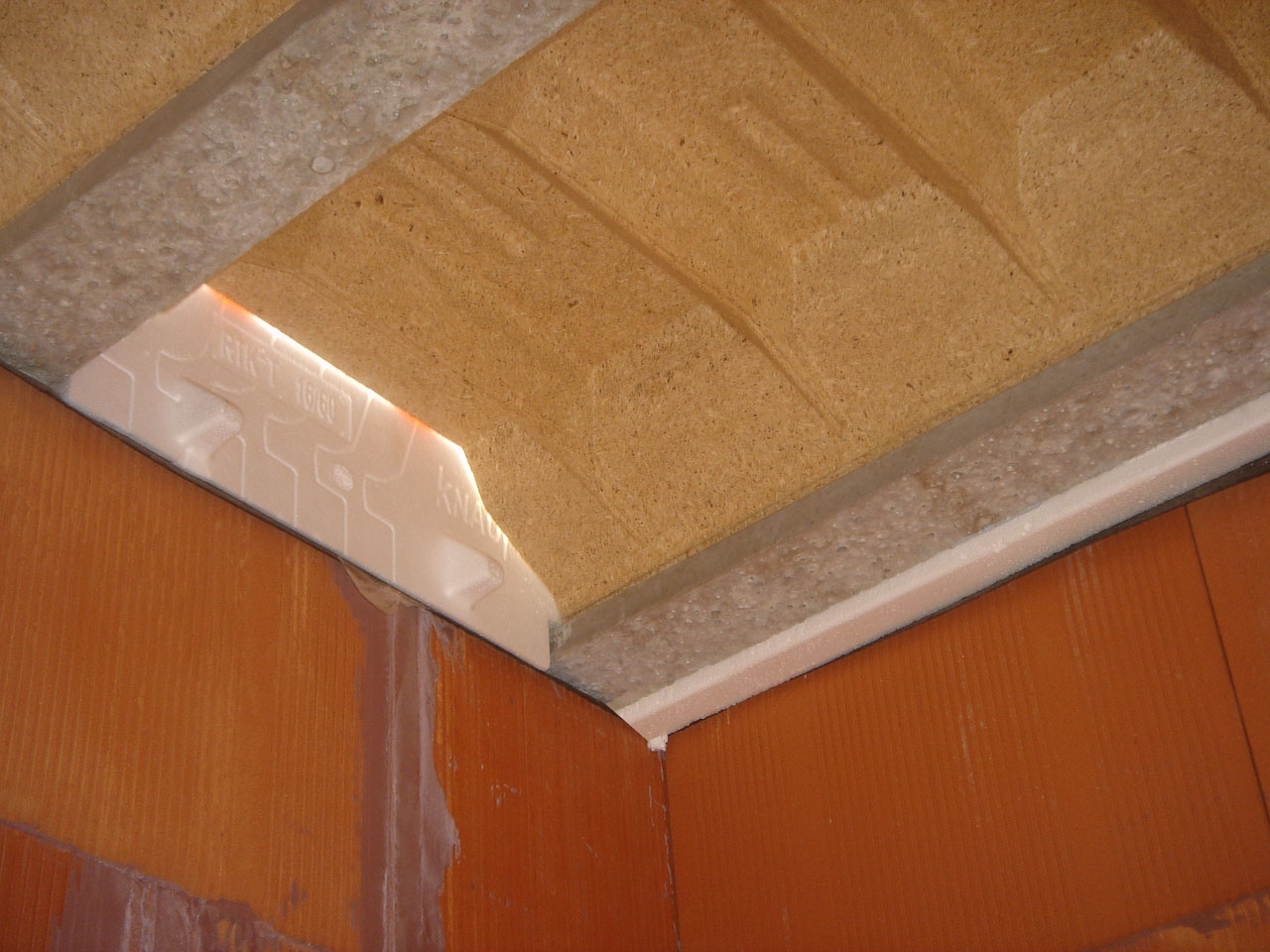
There are two types of polystyrene blocks to break the
thermal connection. : those who are perpendicular to the
concrete beams and those who are parallel to the beams.
|
The technique of breaking the thermal links implies
negligible cost, yet it is little used even in new
construction where it could be most easily applied. Click to
see the KP1's isorupteurs
KP1.
(photos B.C.)
|
To improve the thermal performance of old buildings (renovation)
and suppress the thermal bridges in these existing homes or
buildings, the best solution is external insulation (but it is not as
long-lasting). One might call it an "overcoat wall". It consists of
surrounding the building with a layer of insulating material added on
the outside of the wall, such as, for example, polystyrene associated
with a more rigid wall material &endash; say fiberglass or thin
bricks. See : http://www.frog3.com/jpb/isolationext.htm,
zolpan,
mur
manteau
Windows
 For
the windows we have chosen frames made of PVC, an inexpensive plastic
material which requires no maintenance (painting) and which insulates
better than wood and much better than aluminium. The windows have
double glazing with argon gas between the two panes; this improves
the thermal performance by about 10%. The window panes have a surface
treatment conferring enhanced insulation. It consists of depositing
an ultra-thin and invisible metallic coating on the glass when it is
manufactured. See http://www.uf-pvc.fr/metier/?rub=infotech_thermique.
That thin coating reflects infra-red light and helps to keep that
energy inside the house, but it lets ultra-violet light (sun light)
coming from outside get through. This improves the thermal behaviour
of window glass by about 40%. The additional cost for argon gas and
surface treatment of the glass is quite inexpensive&endash; a few
Euros per square meter for an improvement of 50% in the insulating
quality of the window as compared with a classical double glazed
window. This helps do away with the "cold wall" effect of windows and
avoids condensation. These highly efficient windows obtained by
depositing a thin metallic layer are expected to become legally
required in France in the future. (photos
Rights Reserved.)
For
the windows we have chosen frames made of PVC, an inexpensive plastic
material which requires no maintenance (painting) and which insulates
better than wood and much better than aluminium. The windows have
double glazing with argon gas between the two panes; this improves
the thermal performance by about 10%. The window panes have a surface
treatment conferring enhanced insulation. It consists of depositing
an ultra-thin and invisible metallic coating on the glass when it is
manufactured. See http://www.uf-pvc.fr/metier/?rub=infotech_thermique.
That thin coating reflects infra-red light and helps to keep that
energy inside the house, but it lets ultra-violet light (sun light)
coming from outside get through. This improves the thermal behaviour
of window glass by about 40%. The additional cost for argon gas and
surface treatment of the glass is quite inexpensive&endash; a few
Euros per square meter for an improvement of 50% in the insulating
quality of the window as compared with a classical double glazed
window. This helps do away with the "cold wall" effect of windows and
avoids condensation. These highly efficient windows obtained by
depositing a thin metallic layer are expected to become legally
required in France in the future. (photos
Rights Reserved.)
Insulating front door and garage
door
There are many manufacturers and many models of doors. Some doors
are more insulating than others and the best insulated ones are not
necessarily the most expensive. We have chosen a door of steel on
both surfaces with foam between the two steel plates. It is better
insulating and more solid, it better resists break-in, requires no
maintenance and costs the same as a door made of wood which are
chosen in France by most of the new home-owners by tradition,
although they are less efficient, more expensive, more fragile
mechanically, will not last as long, require being repainted every
few years and are thermally less-efficient.
Wall insulation
There are different systems of insulation. We have chosen St
Gobain's OPTIMA quality GR 32. Its coefficient of insulation is about
30% greater than traditional glass wool, for the same thickness. This
system is about twice as insulating as the 8 cm of polystyrene
habitually installed in most new construction in France these days.
Added to the insulating power of the insulating bricks, we have about
3 times less loss of heat through the walls.
Double-flux ventilation
Instead of heating the atmosphere by exhausting warm air from the
house, the double-flow ventilation (DFV) recovers the heat of
the warm out-going air and transfers it to the intaken air (whence
the term double-flow). This is accomplished by a heat exchanger
consisting of a system of metallic plates. The yield approaches 95%,
that is, 95% of the heat in the exhaust air is transferred to the
intaken air. Installing a DFV system adds a few thousand Euros to the
cost of the house but leads to significant savings of energy as well
as improved comfort. Air flow can be controlled and the air is
filtered and thus of better quality. For his ecological house, Bruno
has selected the DFV
Hélios type KWL EC 450 Pro plant providing up to 450 cubic
meters per hour of pure, filtered and preheated air which enters
through the puits canadien (see below). At 300 cubic meters
per hour, which is quite adequate, and running 24 hours a day, the
DFV will consume 50 watts, and cost about 40 euros a year (and I
remind you that in France electricity is over 90% nuclear and emits
very little CO2).
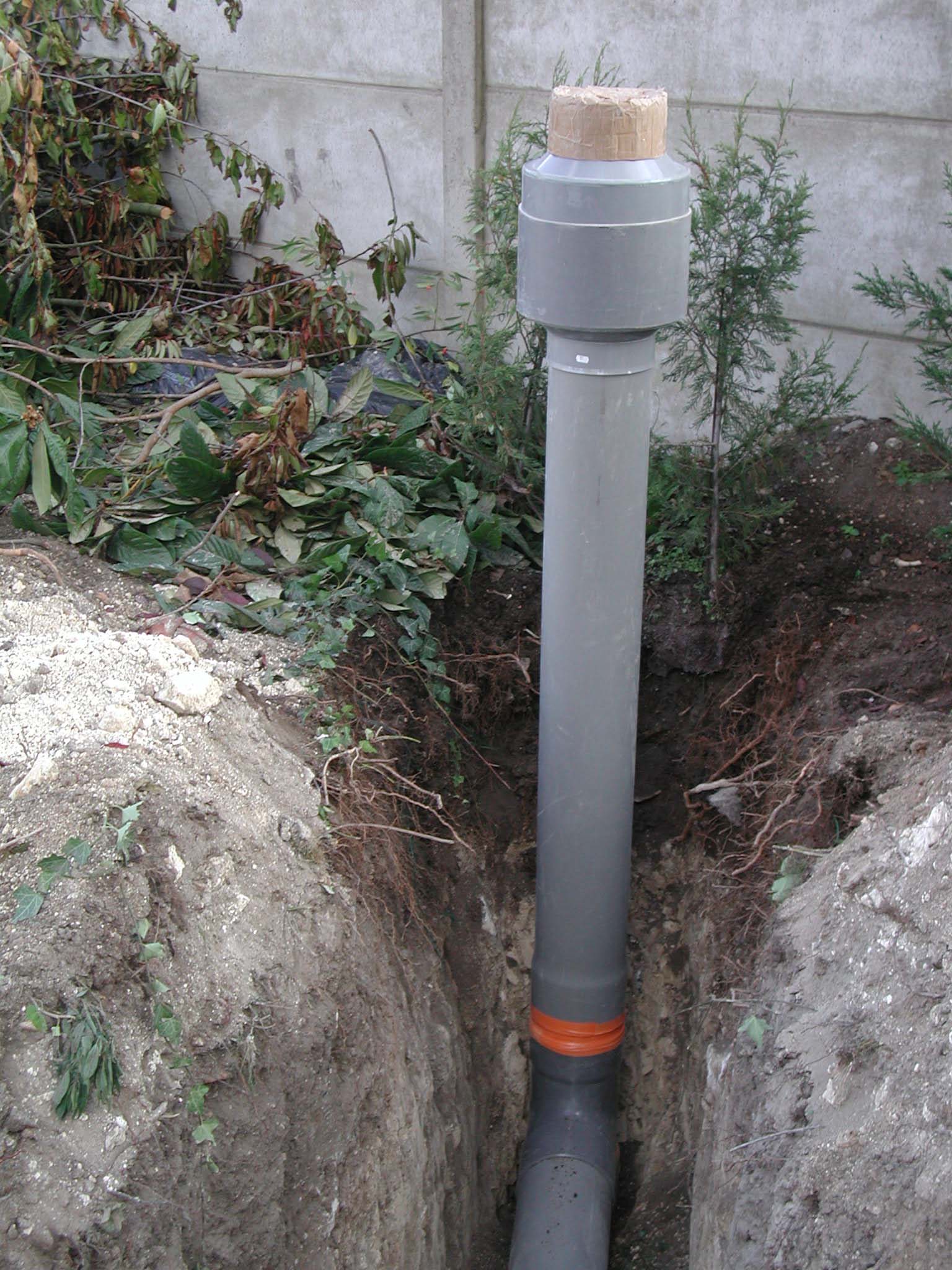 Puits
canadien (earth cooling/warming tubes)
Puits
canadien (earth cooling/warming tubes)
The principle of the puits canadien &endash; to preheat
intake air in winter &endash; or the puits provençal
&endash; to cool intake air in summer &endash; consists of passing
the intake air through pipes buried about 2 meters underground before
it enters the house. At that depth the temperature is very nearly
constant all year 'round &endash; about 14 degrees C. So it is
possible to preheat the intake air in winter, up to about 14 degrees,
and correspondingly to cool the intake air in summer, providing air
conditioning gratis. For an adequate flow of air, the tube
ought to be 15 to 20 cm in diameter and 50 to 100 meters long. A 50
watt electric fan will provide an adequate air flow for a large
house. Click here
for a complete photo report on the our installation of Bruno's
puits canadien in the Paris region .
 Heat
pump for the heating
Heat
pump for the heating
This allows us to heat a dwelling with 3 to 6 times less
electrical energy. Heat pumps operate in various ways pumping heat
from inside the earth around a building, to distribute it inside the
house (low temperature floor heating). At the right you see a photo
of the Viessman Vitocal 300 heat pump which Bruno has chosen for his
ecological house. It extracts geothermal heat from underground. The
heat pump is about the same size as an ordinary gas furnace but it
consumes only electricity, and not much electricity at that: its COP
(Coeffient Of Performance) is 6 which means that is consumes 6 times
less electricity than electric resistance heating, for a given amount
of heat produced. In France, in addition, over 90% of the electricity
is generated without production of CO2, so such a heat pump is very,
very friendly to the environment. The heat pump also produces the hot
water for bath and kitchen, with a COP of about 3.5; much better than
the COP of solar hot water heating which is about 2 or 3 in the Paris
area, requiring much less electric resistive
boosting
Conclusion
Combining these construction methods and technologies in the same
house, reduces the heat requirement by a factor of 5, the energy
consumed by a factor of 20 and the carbon dioxyde emissions by a
factor 200 (in France), compared to a standard construction
satisfying the most recent European regulations now in application
(RT 2005).
For Bruno's ecological
house, the heat pump, the HVAC unit , the
double-flow ventilation and its heat exchanger (DFV) as well as the
entry of the external air through the puits canadien are
grouped together in a small room situated in the basement.
Such a house with all modern comforts should cost no more than 100
Euros per annum for winter heating, with air conditioning thrown in
gratis. It will require practically no maintenance &endash; neither
logs to put in the fireplace nor ashes to sweep out, neither burners
to regulate nor the obligatory annual chimney sweeping. It will emit
virtually no CO2 &endash; about 200 times less than the same house
built to modern standards and gas heated. Everything inside the house
has been optimized to be thermally efficient.
This is an ecologist's
dream house which has come true !
We would like to emphasise that all the techniques and
technologies used by Bruno are available and are or can be
mass-produced.
This optimised ecological dream-house takes advantage of all these
techniques and technologies in order to minimise its energy
requirements to the greatest possible extent. This house exists
&endash; in Houilles, a close suburb of Paris. To our knowledge it is
the only house in the world to achieve this level of energy savings
and comfort.
For additional information, to learn more about the energy
requirements and the performance of this ecological dwelling, to find
the tools and the software to calculate and simulate the thermal and
energy performance of your own house, visit our "blog
de la maison écologique" (in French, see http://babelfish.yahoo.com/
for a free translation of this web page) or come visit the house
under construction.
To visit this ecological house, join
EFN and come see the house or participate in the annual general
meeting of EFN (next annual meeting in Houilles on saturday 13th
december 2008). Journalists can contact EFN (Environmentalists For
Nuclear Energy) at: +33 1 30 86 00 33.
See our blog on this ecological construction project at http://comby.blogspot.com
(see http://babelfish.altavista.com/
for a free translation of this page).
Don't hesitate to contribute to these blogs by clicking on
comments. Your words will be automatically published on the internet
and will help inform the visitors who follow you. (No advertising,
please. Insults and disagreeable passages will not be published. On
the other hand, we welcome additional information and civil
opinion.)














 For
the windows we have chosen frames made of PVC, an inexpensive plastic
material which requires no maintenance (painting) and which insulates
better than wood and much better than aluminium. The windows have
double glazing with argon gas between the two panes; this improves
the thermal performance by about 10%. The window panes have a surface
treatment conferring enhanced insulation. It consists of depositing
an ultra-thin and invisible metallic coating on the glass when it is
manufactured. See
For
the windows we have chosen frames made of PVC, an inexpensive plastic
material which requires no maintenance (painting) and which insulates
better than wood and much better than aluminium. The windows have
double glazing with argon gas between the two panes; this improves
the thermal performance by about 10%. The window panes have a surface
treatment conferring enhanced insulation. It consists of depositing
an ultra-thin and invisible metallic coating on the glass when it is
manufactured. See  Puits
canadien (earth cooling/warming tubes)
Puits
canadien (earth cooling/warming tubes) Heat
pump for the heating
Heat
pump for the heating